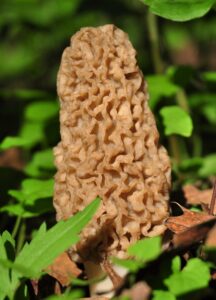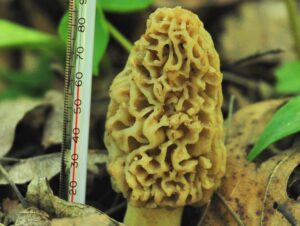Photography courtesy of Lowell Washburn, all rights reserved.
For Iowa mushroom hunters, it’s been a cold, dark, and windy spring. At a time when succulent morels should begin emerging in numbers, nighttime temps hover near or below freezing on an all too frequent basis. As popular woodlands remain void of emerging foliage, some enthusiasts are giving up hope. If it gets much later, they say, there won’t be a mushroom crop at all. Not true. No matter how long it takes, sooner or later, the morels will start popping. The season may be brief, but rest assured that it will come.

I’ve been trying to sneak up on wild mushrooms for more than forty years. I’ve enjoyed early seasons and have endured the late. One of the latest springs I can recall occurred in 2013. The entire season was plagued by numerous weather setbacks, including record May snowfall for several Iowa counties. In the northern half of the state, the first morels didn’t appear until mid-May and the peak didn’t come until the month’s third week.
Although a long time comin’, the hatch was dramatic. While scouring the hardwood timbers near McGregor on May 23, I discovered a single, closely knit patch containing 52 giant yellow morels. Some of the more robust individuals weighed in at nearly six ounces apiece. Other, though less spectacular, groupings were standing nearby. For me, that’s a good find any day. I later heard that local ridge runners were still finding a handful of fresh grays on Memorial Day weekend – an event virtually unheard-of.

When the weather finally breaks this season, hunters need to be ready to roll. Most enthusiasts have their favorite woodland haunts — the secluded side of a south facing slope, an out of the way stand of dead elms, a loamy ridgetop above the river. And while familiarization with these well-guarded locations is important, timing is also critical. When you go to the woods is as equally important as where you go – especially when a late spring is likely to result in a compressed season.
Temperature and moisture are two of the most reliable indicators of when local morel crops are about to emerge. In order to fruit, morel mushrooms need heat. An ideal climate would provide soil temperatures of at least 50 degrees with nighttime air temps in the low to mid-50s and daytime highs reaching around 70 degrees or above. High humidity along with a few well-timed showers will greatly bolster the annual crop. But although these factors can narrow your search window, they are somewhat less than absolute.

Here’s the money shot. Although universally loathed by ultra-urbanized lawn care fanatics, the lowly dandelion is the only absolute rock solid, will-never-ever-let-you-down predictor of when morel mushrooms will annually reach their peak. When the first bright yellow dandelion flowers appear on open lawns or pastures, [those growing along foundations or sidewalks don’t count] you can start your clock — the countdown to sizzling butter-laden skillets of fresh morels has begun. In precisely 10 to 12 days after the first dandelions open their buds, the peak of the spring morel crop will be standing in the woods, silently awaiting your arrival. As sure as brown trout slurp hatching mayflies, you can take this tip to the bank – every single time; every single year. Long live the dandelion.

 Tom Cope
Tom Cope Sue Wilkinson
Sue Wilkinson Susan Judkins Josten
Susan Judkins Josten Rudi Roeslein
Rudi Roeslein Elyssa McFarland
Elyssa McFarland Mark Langgin
Mark Langgin Adam Janke
Adam Janke Joe Henry
Joe Henry Kristin Ashenbrenner
Kristin Ashenbrenner Joe Wilkinson
Joe Wilkinson Dr. Tammy Mildenstein
Dr. Tammy Mildenstein Sean McMahon
Sean McMahon